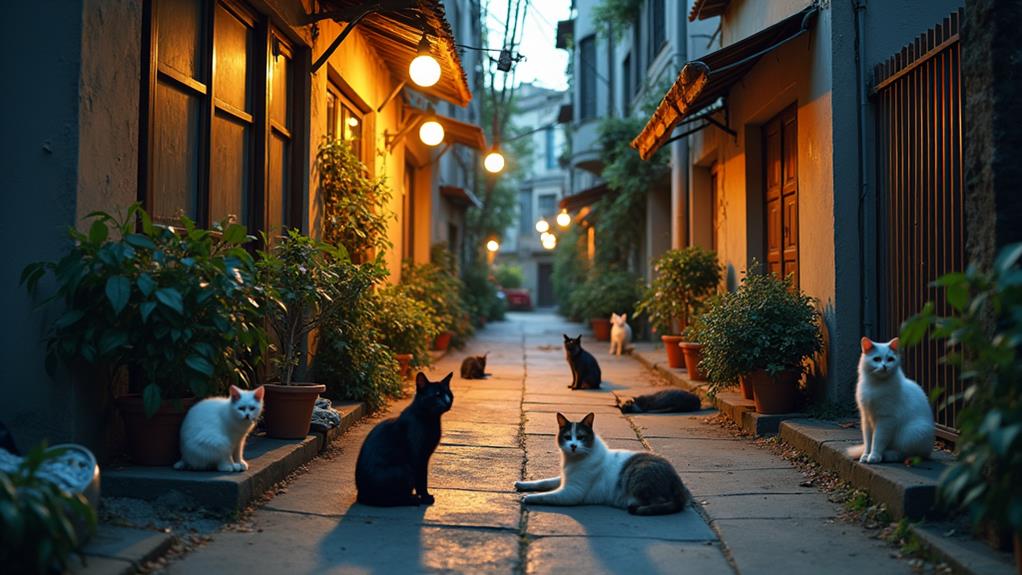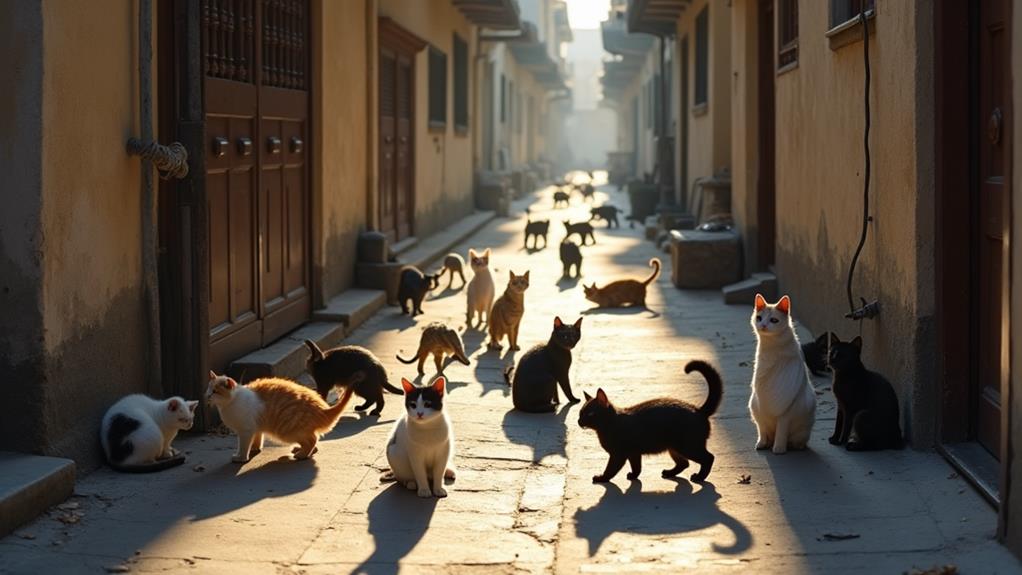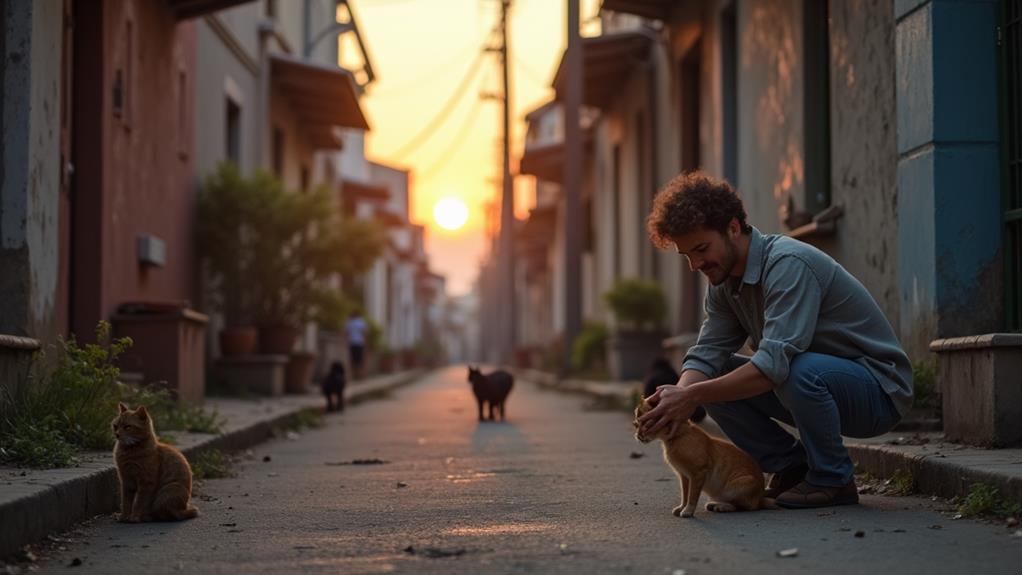What Is a Feral Cat Colony? Understanding Feral Cat Communities

A feral cat colony is a fascinating community of unsocialized cats living together, primarily composed of related females and their offspring. Unlike stray cats, ferals avoid human contact and thrive in supportive, matriarchal societies. These colonies range in size, typically having 3 to 15 members, and adapt based on available resources. Social bonds within the colony are strengthened through grooming and allorubbing, creating a cooperative environment. Males usually interact with the colony only during mating season. Trap-Neuter-Return (TNR) programs are essential for managing population growth and promoting health. There's much more to uncover about these intriguing communities.
Differences Between Feral and Stray Cats
When distinguishing between feral and stray cats, it's important to understand their behavior and background. Feral cats are unsocialized and avoid human contact, living in feral colonies primarily composed of related females and their offspring. In contrast, stray cats have had prior human interaction, often seeking human company, and typically live solitary lives. While a stray might have been lost or abandoned, it can potentially revert to feral behavior if it spends enough time away from humans.
Feral kittens present a unique challenge. Despite attempts at socialization, some remain inherently feral and resist human engagement, unlike stray kittens that can often be re-socialized with patience and care. This distinction is significant for determining the best approach in managing these animals.
TNR programs (Trap-Neuter-Return) are important for feral cats, helping stabilize their populations within feral colonies. Stray cats, however, might benefit more from re-homing and adoption efforts. By understanding these nuances, you can implement more effective intervention strategies and provide the appropriate support for both feral and stray cats, ensuring their well-being and reducing the challenges they face in urban environments.
Social Structure in Colonies
Feral cat colonies function like small, matriarchal societies where related females and their offspring support each other. These colonies are built on a social structure that prioritizes resource sharing and protection. Typically, the colony's size ranges from 3 to 15 members, largely determined by food availability and other essential resources. The social hierarchy within the colony is flexible, allowing dominant females initial access to resources, yet fostering cooperation among members. This flexibility guarantees that even lower-ranking cats can share in the colony's resources when needed.
Adult males usually don't live within the colony but might appear during mating seasons. Their presence creates loose hierarchies, often dictated by territory and size. These males may temporarily contribute to the colony's dynamics, but their role is less stable than that of the related females.
Social interactions play a significant role in maintaining the colony's stability. Activities like grooming and allorubbing aren't just for hygiene; they strengthen bonds between cats. These behaviors help to guarantee the colony remains a cohesive unit, promoting comprehensive health and well-being. Understanding this social structure is key to grasping how feral cat colonies function and thrive in their environments.
Interactions Among Colony Members

Understanding the social structure of feral cat colonies offers insight into their interactions. Feral cat colonies, mainly composed of related females and their offspring, foster strong bonds through social interactions like allorubbing and allogrooming. These behaviors help maintain harmony and comfort among community cats, essential for the colony's stability. You'll notice that these cats share responsibilities, such as caring for the young, which strengthens their social ties.
Within these colonies, aggression is minimal because of the familiarity among females. This peaceful coexistence allows for efficient resource sharing, ensuring the colony's survival. While cats are solitary hunters, they display a remarkable ability to share food when it's abundant. This behavior highlights their adaptability and the significance of food sharing in sustaining the feral cat population.
Adult males generally don't reside within colonies but may occasionally interact with females, especially during mating seasons. However, these interactions are typically limited and don't greatly disrupt the established social dynamics among the females. By observing these interactions, you gain a deeper understanding of how feral cats live in colonies, emphasizing their ability to form cohesive and cooperative communities despite their independent nature.
Male Behavior in Colonies
Observing male behavior in feral cat colonies reveals a complex dynamic driven by hierarchy and territory. In these feral colonies, intact males often establish loose hierarchies primarily determined by size and control over territory. Dominant males usually command larger territories, which may overlap with female colonies. This overlap isn't random; it provides these intact males with increased mating opportunities, a vital aspect of their living outdoors.
Neutered male cats, on the other hand, typically maintain smaller territories and exhibit less territorial aggression than their intact counterparts. This difference in behavior is significant because it affects how they interact with other cats within the colony. While intact males might engage in aggressive interactions to defend their territory from unfamiliar cats, neutered males often display reduced aggression, leading to fewer conflicts.
When it comes to social interactions, male cats generally show less aggression towards females. They often tolerate females during encounters, focusing their competitive energies on other males. This behavior underscores the importance of food and shelter as resources worth defending. In general, understanding these dynamics helps you appreciate the intricate social structures that develop among male cats living in feral colonies.
Trap-Neuter-Return Programs

Having examined the intricacies of male behavior in feral cat colonies, it's advantageous to contemplate how Trap-Neuter-Return (TNR) programs play a crucial role in managing these populations. TNR involves humanely trapping feral cats, then having them spayed or neutered, vaccinated, and returned to their original habitats. This approach not only controls population growth but also improves the comprehensive health and stability of feral cat colonies around you.
When feral cats live in a community where TNR is practiced, they experience reduced nuisance behaviors like fighting and yowling. This is because sterilized cats can't reproduce, which prevents new litters and stabilizes the existing population. TNR programs often include marking the cats, usually by ear-tipping, making it easy to identify those that have been treated. Vaccinations administered during the process further enhance the health of these cats.
Many communities see TNR as a more effective and humane alternative to traditional euthanasia. It allows feral cats to continue living in their familiar environments, often where human-based food sources are accessible, with minimal contact with humans. Consequently, TNR programs provide a sustainable solution for managing feral cat populations.




